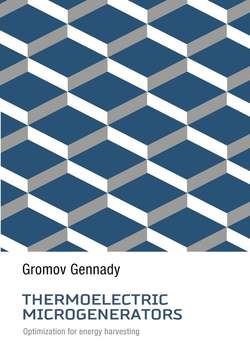Читать книгу Thermoelectric Microgenerators. Optimization for energy harvesting - Gennady Gromov - Страница 5
На сайте Литреса книга снята с продажи.
Chapter 3. Optimization of electrical circuit
ОглавлениеPreface. Thermoelectric generator transforms thermal energy and gives it to external electric circuit. Here coordination of elements of the electric circuit with parameters of the generator is essential for extraction of maximum power. In this Chapter questions of optimization of the electric circuit are considered.
Basic formulas
Simplified electrical circuit of a generator module is shown in Fig.3.1.
Figure. 3.1 Schematics of thermoelectric generator.
Maximum electric power transformed by a generator from heat source is defined by thermoEMF E and internal resistance ACR of the generator.
The thermoEMF E is found as the following
where α – thermoelectric coefficient (Seebeck coefficient) of pair of thermoelements n- and p-types; 2N – number of elements in generator module; ΔT -working temperature difference on generator module (ΔT=Th-Tc).
If to short the electric circuit of the generator (Rload=0), the short-circuit current Isc is
At short-circuit the power Psc allocated in the electric circuit is maximal.
However, all this power will be converted into Joule heat in thermoelements of the generator. In fact, heat converted into electric current returns again into the heat. There is no useful work.
A generator performs useful work when converted power is given out to the external load that has electrical resistance different from zero (Rload> 0).
Then the working current I in the electric circuit (Fig. 3.1) is
Voltage U in the electric circuit, correspondingly
Formula of the net power P has the following form:
Maximum power
From equation (3.6) it follows that the generated power Pnonlinearly dependends on the load resistance Rload.
Figure. 3.2 Sample dependence of generator power (four variants by ACR) from the load resistance. Temperature difference 5°C.
This dependence has maximum power Pmax when external load resistance Rload is equal to internal resistance ACR of the generator (Rload=ACR):
– At given internal resistance ACR of generator, there is an optimal load resistance Rload in terms of maximum power conversion.
– On the other side also follows from the equation (3.6) that at the given loading resistance Rload, the less internal resistance ACRof generator, then more power P (an example, Fig. 3.2 – an arrow up).
– At the same time, for such generator with smaller resistance ACR, there is even more optimal loading (Fig. 3.2 – arrow sideways) with smaller resistance Rload (Fig. 3.2 – red arrow down) which provides even more power.
Maximum power Pmax conversion occurs when:
And corresponding maximum electric current Imax
Comparing (3.2) and (3.3) and (3.7) (3.8) respectively, we get:
– Maximum power Pmax that can be obtained by thermoelectric generator is only one quarter of the maximum available transformed power by the generator (short circuit capacity).
– Electric current Imax through the module in maximum power output is half of short-circuit electric current Isc (3.2).
